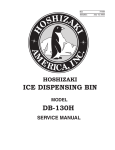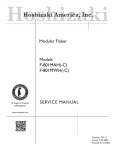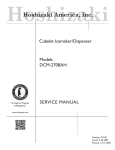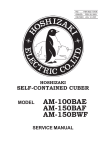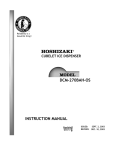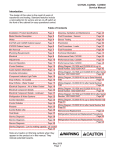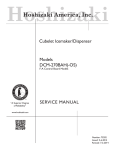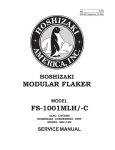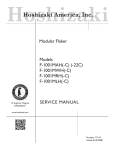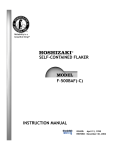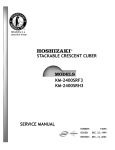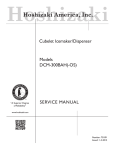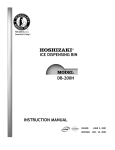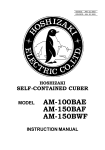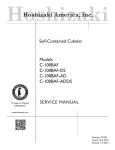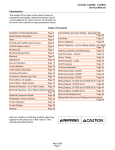Download Hoshizaki DCM-270BAH-OS User's Manual
Transcript
Reliability is a beautiful thingTM CUBELET ICE DISPENSER DCM-270BAH-OS SERVICE MANUAL ITEM #: 73110 ISSUED: February 10, 2004 REVISED: May 26, 2005 IMPORTANT Only qualified service technicians should attempt to service or maintain this ice dispenser. No service or maintenance should be undertaken until the technician has thoroughly read this service manual. HOSHIZAKI provides this manual primarily to assist qualified service technicians in the service and maintenance of the dispenser. Should the reader have any questions or concerns which have not been satisfactorily addressed, please call or write to the HOSHIZAKI Technical Support Department for assistance. HOSHIZAKI provides this manual primarily to assist qualified service technicians in the service and maintenance of the dispenser. Should the reader have any questions or concerns which have not been satisfactorily addressed, please call or write to the HOSHIZAKI Technical Support Department for assistance. HOSHIZAKI AMERICA, INC. 618 Highway 74 South Peachtree City, GA 30269 Attn: HOSHIZAKI Technical Support Department Phone: 1-800-233-1940 Technical Service (770) 487-2331 Fax: (770) 487-3360 Web Site: www.hoshizakiamerica.com NOTE: To expedite assistance, all correspondence/communication MUST include the following information: • Model Number • Serial Number • Complete and detailed explanation of the problem 2 Please review this manual. It should be read carefully before the ice dispenser is serviced or maintenance operations performed. Only qualified service technicians should service and maintain the dispenser. This manual should be made available to the technician prior to service or maintenance. CONTENTS I. Specifications .................................................................................................................... 4 1. DCM-270BAH-OS (air-cooled) ..................................................................................... 4 II. General Information .......................................................................................................... 5 1. Construction ................................................................................................................. 5 2.Operation - How it works ............................................................................................... 6 III. Technical Information ....................................................................................................... 7 1. Water Circuit and Refrigerant Circuit............................................................................. 7 2. Performance Data ......................................................................................................... 8 [a] DCM-270BAH-OS (air-cooled) .............................................................................. 8 3. Wiring Diagram ............................................................................................................. 9 4. Sequence of Electrical Circuit .................................................................................... 10 IV. Service Diagnosis .......................................................................................................... 20 1. No Ice Production ....................................................................................................... 20 2. Low Ice Production ..................................................................................................... 22 3. Faulty Dispenser......................................................................................................... 23 [a] Optical Sensor Description .................................................................................. 23 4. Other ........................................................................................................................... 25 V. Removal and Replacement of Components ................................................................... 26 1. Service for Refrigerant Lines ...................................................................................... 26 [a] Refrigerant Recovery........................................................................................... 26 [b] Evacuation and Recharge [R-404A] .................................................................... 26 2. Brazing ....................................................................................................................... 27 3. Removal and Replacement of Compressor ................................................................ 28 4. Removal and Replacement of Drier ........................................................................... 29 5. Removal and Replacement of Thermostatic Expansion Valve ................................... 30 6. Removal and Replacement of Pressure Switch ......................................................... 31 7. Removal and Replacement of Control Water Valve .................................................... 32 8. Removal and Replacement of Flush Water Valve ....................................................... 33 9. Removal and Replacement of Float Switch................................................................ 34 10. Removal and Replacement of Bin Control Switch Assembly ................................... 35 11. Removal and Replacement of Storage Bin Assembly .............................................. 36 12. Removal and Replacement of Agitator and Drip Ring .............................................. 37 13. Removal and Replacement of Evaporator Assembly ............................................... 38 VI. Cleaning and Maintenance Instructions ........................................................................ 41 1. Preparing the Ice Dispenser for Long Storage ............................................................ 41 2. Cleaning Instructions .................................................................................................. 42 [a] Cleaning Procedure ............................................................................................ 42 [b] Sanitizing Procedure ........................................................................................... 45 2. Maintenance Instructions ............................................................................................ 46 3 I. Specifications 1. DCM-270BAH-OS (air-cooled) AC SUPPLY VOLTAGE AMPERAGE MAXIMUM FUSE SIZE MINIMUM CIRCUIT AMPACITY APPROXIMATE ICE PRODUCTION PER 24 HR. lbs./day ( kg/day ) Reference without *marks SHAPE OF ICE ICE QUALITY APPROXIMATE STORAGE CAPACITY ELECTRIC & WATER CONSUMPTION ELECTRIC W (kWH/100 lbs.) POTABLE WATER gal./24HR (gal./100 lbs.) EXTERIOR DIMENSIONS (WxDxH) EXTERIOR FINISH WEIGHT CONNECTIONS - ELECTRIC - WATER SUPPLY - DRAIN ICE MAKING SYSTEM HARVESTING SYSTEM ICE MAKING WATER CONTROL COOLING WATER CONTROL DISPENSER CONTROL SYSTEM BIN CONTROL SYSTEM COMPRESSOR CONDENSER EVAPORATOR REFRIGERANT CONTROL REFRIGERANT CHARGE DESIGN PRESSURE COMPRESSOR PROTECTION GEAR MOTOR PROTECTION REFRIGERANT CIRCUIT PROTECTION LOW WATER PROTECTION ACCESSORIES - SUPPLIED OPERATING CONDITIONS 115/60/1 8.5 A [AT 104°F(40°C)/WT 80°F(27°C)] N/A N/A WATER TEMP. (°F) Ambient 50 70 90 Temp.(°F) 70 * 288 (131) 276 (125) 265 (120) 80 254 (115) 243 (110) 233 (106) 90 224 (101) * 220 (100) 205 (93) 100 197 (89) 189 (86) * 176 (80) Cubelet (Compressed Flake Ice) Approx. 90%, Ice (90/70°F, Conductivity 200 µs/cm) 8.8 lbs. 90/70°F 70/50°F 669 (7.3) 638 (5.3) 26 (12) 35 (12) 16-9/16" x 24-1/8" x 31-11/16" (420 x 613 x 805mm) Stainless Steel Net 152 lbs. ( 69 kg ), Shipping 170 lbs. ( 77kg ) Cord Connection Inlet 1/2" FPT Outlet 3/4" FPT Auger type Direct Driven Auger ( 80W Gear Motor ) Float Switch N/A Photoelectric Sensor (Infrared) Mechanical Bin Control ( Proximity Sw. ) Hermetic, Model ASE24C3E Air-cooled, Fin and Tube Type Copper Tube on Cylinder Thermostatic Expansion Valve 14.8 oz. R-404A, (420 g) High 460 PSIG, Low 290 PSIG Auto-reset Overload Protector Manual reset Circuit Breaker Auto-reset High Pressure Control Switch Float Switch and Timer N/A VOLTAGE RANGE 104 - 127 V AMBIENT TEMP. 45 - 100° F WATER SUPPLY TEMP. 45 - 90° F WATER SUPPLY PRESSURE 10 - 113 PSIG We reserve the right to make changes in specifications and design without prior notice. 4 II. General Information 1. Construction The Hoshizaki Cubelet Ice Dispenser, model DCM-270BAH-OS includes water supply, freezer, condensing, storage, dispensing and control assemblies. Fig. 1 Note: *Adjustable Legs Minimum height - 4" Maximum height - 5.3" Do not adjust exceeding the above recommendation. 5 2.Operation - How it works Water flows from the potable water source through the water supply line shut-off valve, enters at the water inlet fitting and into the water reservoir. The water reservoir functions to maintain a constant water level inside the freezer assembly. Water from the water reservoir enters at the bottom of the freezer. Heat is removed by the refrigeration process and ice forms inside the freezer. A stainless steel auger, located inside the freezer, is direct-driven by the gear motor, and the rotating auger carries the ice upward to the end of the auger, where excess water is pressed out of the ice, as the ice is extruded and broken into cubelet ice (compressed ice) and then pushed out into the storage bin. Moving the power switch on the bottom left of the middle front panel, to the “ON” position starts the automatic and continuous icemaking process. When the ice storage bin is filled with ice, the bin control switch will shut off the icemaking process. As the ice is removed from the storage bin, the bin control switch resets automatically and restarts the icemaking process. The agitator in the storage bin keeps the ice from clustering so that the ice can move easily through the spout. Fig. 2 6 III. Technical Information 1. Water Circuit and Refrigerant Circuit 7 2. Performance Data [a] DCM-270BAH-OS (air-cooled) Note: Pressure data is recorded first 5 minutes in freezing cycle. The data without *marks should be used for reference. We reserve the right to make changes in specifications and design without prior notice. 8 3. Wiring Diagram 9 4. Sequence of Electrical Circuit POWER ON WATER STARTS TO BE SUPPLIED TO RESERVOIR AGITATION TIMER ON - (2 SEC.) 10 RESERVOIR FILLS UP GEAR MOTOR TURNS ON 11 COMPRESSOR STARTS 60 SEC. AFTER GEAR MOTOR. 12 ICE MAKING CONTINUES. START CAPACITOR TAKEN OUT OF CIRCUIT 13 BIN CONTROL TRIPS. COMPRESSOR STOPS 90 SECONDS LATER. 14 GEAR MOTOR STOPS 60 SECONDS AFTER COMPRESSOR. 15 DISPENSE ICE (BIN CONTROL STILL TRIPPED) 16 FLUSH SWITCH ACTIVATED. 17 FLUSH TIMER ACTIVATED. 18 AGITATION TIMER ACTIVATES GEAR MOTOR. 19 IV. Service Diagnosis 1. No Ice Production PROBLEM [1] The ice dispenser will not start. POSSIBLE CAUSE a) Power Supply Cord b) Power Switch (on left bottom of front panel) c) Fuse 1A (Control Box) [2] Water valve operates, a) Water Supply Line but no ice is produced. b) Water Valve c) Water Control Relay [3] Compressor will not start. 4. Blown fuse. 1. OFF position. 1. Blown out. 1. Shut-off valve closed. 2. Water supply off. 1. Clogged. 1. Bad contacts (terminal nos. 4 and 6). d) Timer 2. Coil winding opened. 3. Loose connections. 1. Bad contacts. a) Compressor 2. 3. 4. 1. b) Timer c) Motor Protector d) Starter [4] Gear motor will not start. 1. Broken or loose connection. 2. Loose connection. 3. Bad contacts. e) Starting Capacitor a) Gear Motor b) Timer c) Protect Relay d) Protector e) Capacitor REMEDY 1. Check for contintinuity and replace. 2. Tighten. 3. Check for contintinuity and replace. 4. Replace. 1. Move to ON position. 1. Check for short circuit and replace. 1. Open. 2. Check and get recommended pressure. 1. Clean. 1. Check for continuity and replace. 2. Replace. 3. Tighten. 1. Check for continuity and replace. 2. Replace. 3. Tighten. 4. Replace. 1. Replace. Coil winding opened. Loose connections. Defective. Motor winding opened or grounded. 1. Bad contacts (X2 relay). 1. Check for continuity and replace. 2. X2 relay coil winding 2. Replace. opened. 3. Loose connections. 3. Tighten. 1. Bad contacts. 1. Check for continuity and replace. 1. Bad contacts. 1. Check for continuity and replace. 1. Defective. 1. Replace. 1. Motor winding opened. 1. Replace. 1. Bad contacts (X1 relay). 1. Check for continuity and replace. 1. Bad contacts. 1. Check for continuity and replace. 2. Coil winding opened. 2. Replace. 3. Loose connections. 3. Tighten. 1. Bad contact. 1. Check for continuity and replace. 1. Defective. 1. Replace. 20 PROBLEM POSSIBLE CAUSE [5] Fan motor will not start. a) Fan Motor b) Timer REMEDY 1. Motor winding opened. 1. Replace. 2. Bearing worn out. 2. Replace. 3. Wiring to fan motor. 3. Check for loose connection or open, and replace. 4. Fan blade bound. 4. Check and replace. 1. Bad contacts (X2 relay). 1. Check for continuity and replace. 2. X2 relay coil winding opened. [6] No water or poor flow. a) Water Supply 3. Loose connections. 1. Water failure or pressure too low. 2. b) Water Valve c) Float Switch d) Water Control Relay 1. 2. 1. 2. 1. 2. [7] Ice dispenser will not stop even if out of water. e) Bin Control Switch 1. f) Ice Making Switch 1. 2. a) Float Switch 1. 2. 1. b) Water Control Relay 21 2. Replace. 3. Tighten. 1. Wait until water is supplied or adjust the pressure range within 10-113 PSIG. Shut-off valve closed or 2. Open. restricted. Clogged filter. 1. Clean. Coil winding opened. 2. Replace. Contacts fused. 1. Replace. Clogged. 2. Clean. Bad contacts (terminal 1. Check for continuity and nos. 1 and 5). replace. Contacts fused 2. Replace. (terminal nos. 3 and 5). Bad contacts. 1. Check for continuity and replace. "OFF" position. 1. Move to "ON" position. Bad contacts. 2. Check for continuity and replace. Contacts fused. 1. Replace. Clogged. 2. Clean. Contacts fused 1. Replace. (terminal nos. 4 and 6). 2. Low Ice Production PROBLEM POSSIBLE CAUSE [1] Abnormal refrigeration a) Condenser circuit. 1. Dirty air filter or condenser. 2. Bad ventilation. REMEDY 1. Clean. 2. Remove anything blocking vents. b) Thermostatic Expansion 1. Low-side pressure or 1. Secure bulb to low-side line Valve temperature exceeding or replace. the limit. c) Refrigerant Lines 1. Gas leaks. 1. Check for leaks with a leak detector. Reweld leak, replace drier and charge with refrigerant. The amount of refrigerant is marked on the nameplate. d) Compressor Motor Protector 2. Overcharged. 2. Recharge. 1. Overload protector stops compressor intermittently. 1. Check condenser and fan motor. e) Inside Wall of Evaporator 1. Scale on inside wall of freezing cylinder. 1. Remove auger, use Hoshizaki "Scale Away" or "LIME-A-WAY" solution to clean periodically. If water is found to exceed the following levels, install a conditioner: Hardness 50 ppm Silica 30 ppm [2] Condensing temperature too high. a) Condenser 1. Dirty air filter or condenser. 2. Bad ventilation. 1. Clean. 3. Ambient temperature too high. 3. Check ventilation and location, and change as needed. 2. Remove anything blocking vents. 4. Less than 6" clearance 4. Allow proper clearance for at rear, sides and top. ventilation. b) Fan Motor [3] Poor water flow. a) Water Supply 1. Fan revolving too 1. See chart 1,[5], a) slowly. 1. Water pressure too low. 1. See chart 1,[6], a) 22 3. Faulty Dispenser PROBLEM [1] No ice is dispensed. POSSIBLE CAUSE a) Storage Bin 1. Ice block or bridge. 2. Incorrect wiring. 1. Deformed due to ice block or bridge. c) Solenoid 1. Coil winding opened. d) Ice switch or dispensing 1. Bad contacts. sensor. e) Ice Dispensing Relay 1. Bad contacts. b) Agitator [2] No water is dispensed. a) Water Valve (Dispensing) b) Water Dispensing Sensor [3] Ice keeps being a) Shutter dispensed. b) Ice Switch Dispensing Switch 1. Clogged filter. 1. Bad circuit. 1. Faulty adjustment. 1. Contacts fused. REMEDY 1. Remove all ice from storage bin when not using ice dispenser for a long time. 2. Correct wiring. 1. Replace. 1. Replace. 1. Check for continuity and replace. 1. Check for continuity and replace. 1. Clean. 1. Check for continuity and replace. 1. With shutter closed, lock shutter in place by securing with two screws at the lower part of the solenoid and two screws under solenoid. 1. Replace. [a] Optical Sensor Description This model incorporates touch-free optical sensors to control ice and water dispensing. The sensors operate by using an emitter and two receivers encased in a waterproof sensor housing. They are designed to operate in normal lighting conditions. Direct sunlight, however, may cause the sensors to malfunction. The sensors will work with most shades (colors) of cups with a sensing distance of 45 to 65 mm. In certain water conditions, the lenses of the sensor may become scaled. Scale can block the sensor and affect the sensing operation. This scale can be removed by using a solution of Scale Away (6 fl. oz per 1 gal. of water) or other non-abrasive cleaner. This DCM uses a different control board (part number 2A2867-01) than the push button style of DCM. This board provides an internal power source for the sensing circuit and has an additional connector (K5). This board is not interchangeable with the control board used on the push button version. When troubleshooting the sensor operation, we will be concerned with the K5 and K2 connectors on the control board. The K2 connector will supply line voltage (115VAC) to the ice dispensing motor and ice dispensing solenoid and 24VAC to the water dispense solenoid. The K5 connector provides the input and output from the sensors. These sensors control water dispense and ice dispense in both the portion and continuous dispense operation. The ice dispense time is limited to 60 seconds regardless of whether the customer is using the “Continuous” or the “Portion Control” function. This nonadjustable, maximum timer prevents continuous dispense if someone inadvertently leaves an object in front of the dispense sensor. 23 If you experience problems with the ice or water dispense, use the following charts along with the wiring diagram (section III, 3) to guide you through your troubleshooting. The following tables show the proper voltage readings for each operation. Ice Dispensing in Continuous Mode Lead 1 K2 PIN 6 to (LBU) Lead 2 Dispense Non-Dispense GND or NEUTRAL K5 PIN 4 to K5 PIN 5 (Y) or (W/O) or (WH) on (RED) on sensor sensor K5 PIN 4 to K5 PIN 6 (W/O) (W/BR) or or (RED) on (BK) on sensor sensor 120 VAC 0 VAC 5 VDC 0 VDC 5 VDC 5 VDC Water Dispensing Lead 1 Lead 2 K2 PIN 8 to K4 PIN 2 (DBU) (LBU) K5 PIN 7 to K5 PIN 9 (RED) (BK) K5 PIN 7 to K5 PIN 8 (RED) (WH) Ice Dispensing in Portion Controlled Mode Lead 1 K2 PIN 6 to (LBU) Lead 2 Dispense Non-Dispense GND or 120 VAC 0 VAC NEUTRAL K5 PIN 1 to K5 PIN 3 (W/R) (W/BK) or or 5 VDC 5 VDC (RED) on (BK) on sensor sensor K5 PIN 1 to K5 PIN 2 (W/R) (W/BL) or or (RED) on (WH) on sensor sensor 5 VDC 0 VDC Layout of Portion Control Switch Wiring (Front of Machine) Dispense Non-Dispense 24 VAC 0 VAC 5 VDC 5 VDC 5 VDC 0 VDC The K2 connector supplies voltage to the ice and water dispense motors and solenoids through pins 4, 6, 8. The K2 connector also has the gear motor protect circuit on pins 1, 2 the flush valve circuit on pins 9, 10 and voltage inputs on pins 3, 5, 7. The K5 connector is used exclusively for the input and output signals for the optical sensors. 24 4. Other PROBLEM [1] Ice dispenser will not stop even if filled with ice. [2] Reservoir overflows (water will not stop). POSSIBLE CAUSE a) Bin Control Switch b) Water Control Relay c) Timer a) Water Supply 1. 2. 1. 1. 1. Contacts fused. Out of position. Contacts fused. Defective. Water pressure too high. b) Water Valve c) Float Switch d) [3] A lot of water drains from gear motor drain pipe. [4] Abnormal noise. a) a) b) c) d) 1. Cannot close. 1. Bad contacts (red and black leads). 2. Defective. Water Control Relay 1. Coil winding opened. 2. Bad contacts (terminal nos. 1 and 3) Mechanical Seal 1. Dirt stuck on seal (normally less than .017 surface. 2. Worn out. fl. oz./hour) Fan Motor 1. Bearings worn out. 2. Fan blade deformed. 3. Fan blade caught on foreign object. Compressor 1. Bearings worn out or cylinder valve broken. 2. Mounting pad out of position. Refrigerant Lines 1. Rubbing or touching lines or other surfaces. Gear Motor (Ice Making) 1. Bearing or gear worn out / damaged. e) Evaporator f) Solenoid (Shutter) g) Water Valve h) Extruding Head i) Housing 1. Scale on inside wall of freezing cylinder. 1. Worn out. 2. Foreign matter on plunger surface. 1. Foreign matter on plunger. 1. Bearing worn out. 1. Bearing worn out. 25 REMEDY 1. Replace. 2. Reinstall. 1. Replace. 1. Replace. 1. If pressure is consistently too high, install a pressure reducing valve. 1. Clean or replace. 1. Check for continuity and replace. 2. Replace. 1. Replace. 2. Check for continuity and replace. 1. Clean or replace. 2. 1. 2. 3. Replace. Replace. Replace fan blade. Remove the object. 1. Replace. 2. Reinstall. 1. Replace. 1. Replace. 1. See chart 2,[1], e) 1. Replace. 2. Clean. 1. Clean. 1. Replace. 1. Replace. V. Removal and Replacement of Components IMPORTANT Ensure all components, fasteners and thumbscrews are securely in place after the equipment is serviced. IMPORTANT 1. The Polyol Ester (POE) oils used in R-404A units can absorb moisture quickly. Therefore it is important to prevent moisture from entering the system when replacing or servicing parts. 2. Always install a new filter drier every time the sealed refrigeration system is opened. 3. Do not leave the system open for longer than 5 minutes when replacing or servicing parts. 1. Service for Refrigerant Lines [a] Refrigerant Recovery The icemaker unit is provided with two refrigerant access valves–one on the low-side and one on the high-side line. Using proper refrigerant practices, recover the refrigerant from these two access valves and store it in an approved container. Do not discharge the refrigerant into the atmosphere. [b] Evacuation and Recharge [R-404A] 1) Attach charging hoses, a service manifold and a vacuum pump to the system. Be sure to connect charging hoses to both high and low-side access valves. IMPORTANT The vacuum level and vacuum pump may be the same as those for current refrigerants. However, the rubber hose and gauge manifold to be used for evacuation and refrigerant charge should be exclusively for POE oils. 2) Turn on the vacuum pump. Never allow the oil in the vacuum pump to flow backward. 3) Allow the vacuum pump to pull down to a 29.9" Hg vacuum. Evacuating period depends on pump capacity. 26 4) Close the low-side valve and high-side valve on the service manifold. 5) Disconnect the vacuum pump, and attach a refrigerant service cylinder to the high-side line. Remember to loosen the connection, and purge the air from the hose. See the nameplate for the required refrigerant charge. Hoshizaki recommends only virgin refrigerant or reclaimed refrigerant which meets ARI Standard No. 700-88 be used. 6) A liquid charge is recommended for charging an R-404A system. Invert the service cylinder. Open the high-side, service manifold valve. 7) Allow the system to charge with liquid until the pressures balance. 8) If necessary, add any remaining charge to the system through the low-side. Use a throttling valve or liquid dispensing device to add the remaining liquid charge through the low-side access port with the unit running. 9) Close the two refrigerant access valves, and disconnect the hoses and service manifold. 10) Cap the access valves to prevent a possible leak. 2. Brazing DANGER 1. Refrigerant R-404A itself is not flammable at atmospheric pressure and temperatures up to 176° F. 2. Refrigerant R-404A itself is not explosive or poisonous. However, when exposed to high temperatures (open flames) R-404A can be decomposed to form hydrofluoric acid and carbonyl fluoride both of which are hazardous. 3. Always recover the refrigerant and store it in an approved container. Do not discharge the refrigerant into the atmosphere. 4. Do not use silver alloy or copper alloy containing arsenic. 5. Do not use R-404A as a mixture with pressurized air for leak testing. Refrigerant leaks can be detected by charging the unit with a little refrigerant, raising the pressure with nitrogen and using an electronic leak detector. Note: All brazing connections inside the bin are clear-paint coated. Sandpaper the brazing connections before unbrazing the components. Use a good abrasive cloth to remove coating. 27 3. Removal and Replacement of Compressor IMPORTANT Always install a new drier every time the sealed refrigeration system is opened. Do not replace the drier until after all other repair or replacement has been made. Note: When replacing a compressor with a defective winding, be sure to install the new start capacitor and start relay supplied with the replacement compressor. Due to the ability of the POE oil in the compressor to absorb moisture quickly, the compressor must not be opened more than 15 minutes for replacement or service. Do not mix lubricants of different compressors even if both are charged with R-404A, except when they use the same lubricant. 1) Turn off the power supply and unplug the dispenser. 2) Remove the panels. 3) Remove the terminal cover on the compressor, and disconnect the compressor wiring. 4) Recover the refrigerant and store it in an approved container. 5) Remove the discharge and suction pipes using brazing equipment. WARNING When repairing a refrigerant system, be careful not to let the burner flame contact the lead wires or insulation. 6) Remove the hold-down bolts, washers and rubber grommets. 7) Slide and remove the compressor. Unpack the new compressor package. Install the new compressor. 8) Attach the rubber grommets of the prior compressor. 9) Sandpaper the suction, discharge and process pipes. 10) Place the compressor in position, and secure it using the bolts and washers. 11) Remove plugs from the suction, discharge and process pipes. 28 12) Braze the process, suction and discharge lines (do not change this order), while purging with nitrogen gas flowing at the pressure 3-4 PSIG. 13) Install the new filter drier. 14) Check for leaks using nitrogen gas (140 PSIG) and soap bubbles. 15) Connect the terminals, and replace the terminal cover in its correct position. 16) Evacuate the system, and charge it with refrigerant. See the nameplate for the required refrigerant charge. 17) Replace the panels in their correct positions. 18) Plug in the dispenser and turn on the power supply. 4. Removal and Replacement of Drier IMPORTANT Always install a new drier every time the sealed refrigeration system is opened. Do not replace the drier until after all other repair or replacement has been made. 1) Turn off the power supply and unplug the icemaker. 2) Remove the panels. 3) Recover the refrigerant and store it in an approved container. 4) Remove the drier using brazing equipment. 5) Install the new drier, in the direction of the refrigerant flow. Use nitrogen gas at a pressure of 3-4 PSIG when brazing the tubings. 6) Check for leaks using nitrogen gas (140 PSIG) and soap bubbles. 7) Evacuate the system, and charge it with refrigerant. See the nameplate for the required refrigerant charge. 8) Replace the panels in their correct positions. 9) Plug in the dispenser, and turn on the power supply. 29 5. Removal and Replacement of Thermostatic Expansion Valve IMPORTANT Sometimes moisture in the refrigerant circuit exceeds the drier capacity and freezes up at the expansion valve. Always install a new drier every time the sealed refrigeration system is opened. Do not replace the drier until after all other repair or replacement has been made. 1) Turn off the power supply, and unplug the dispenser. 2) Remove the panels. 3) Recover the refrigerant and store it in an approved container. 4) Remove the insulation and the expansion valve bulb on the suction line. 5) Remove the expansion valve cover, and disconnect the expansion valve using brazing equipment. 6) Braze the new expansion valve, with nitrogen gas flowing at a pressure of 3-4 PSIG. WARNING 1. Do not heat the wall. Place a steel barrier for protection. 2. Always protect the valve body by using a damp cloth to prevent the valve from overheating. Do not braze with the valve body exceeding 250°F. 7) Install the new drier. 8) Check for leaks using nitrogen gas (140 PSIG) and soap bubbles. 9) Evacuate the system, and charge it with refrigerant. See the nameplate for the required refrigerant charge. 10) Place the expansion valve in position. 11) Place the new set of expansion valve covers in position. 12) Attach the expansion valve bulb to the low-side line, and secure it with bulb holder and clamps. 13) Cover the expansion valve bulb tightly with the insulation. 30 14) Place the new expansion valve cover in position. 15) Replace the panels in their correct positions. 16) Plug in the dispenser and turn on the power supply. 6. Removal and Replacement of Pressure Switch IMPORTANT Always install a new drier every time the sealed refrigeration system is opened. Do not replace the drier until after all other repair or replacement has been made. 1) Turn off the power supply and unplug the dispenser. 2) Remove the panels. 3) Recover the refrigerant and store it in an approved container. 4) Remove the control box cover and disconnect the terminals. 5) Remove the pressure switch using brazing equipment. 6) Braze the new pressure switch with nitrogen gas flowing at the pressure of 3-4 PSIG. 7) Install the new drier. 8) Check for leaks using nitrogen gas (140 PSIG) and soap bubbles. 9) Evacuate the system, and charge it with refrigerant. See the nameplate for the required refrigerant charge. 10) Replace the terminals and the control box cover in their correct positions. 11) Replace the panels in their correct positions. 12) Plug in the dispenser and turn on the power supply. 31 7. Removal and Replacement of Control Water Valve 1) Unplug the icemaker. 2) Remove the panels. 3) Close the water supply line shut-off valve. 4) Disconnect the terminal from the control water valve. 5) Loosen the fitting nut on the control water valve inlets, and remove the control water valve. Do not lose the packings inside the fitting nut. 6) Remove the water supply hose from the control water valve. 7) Install the new control water valve. 8) Assemble the removed parts in the reverse order of the above procedure. 9) Open the water supply line shut-off valve. 10) Check for water leaks. 11) Replace the panels in their correct position. 12) Plug in the icemaker. 32 8. Removal and Replacement of Flush Water Valve 1) Turn off the power supply. 2) Remove the panels. 3) Close the water supply line shut-off valve. 4) Remove the clamp and disconnect the hose from the flush water valve that attaches to the evaporator. Note: Water may still remain inside the evaporator. Be sure to drain the water into the drain pan. 5) Disconnect the flush water valve from the tube connected to the plastic tee leading to the drain hose. 6) Disconnect the terminals from the flush water valve. 7) Remove the flush water valve from the frame or bracket. 8) Connect the new flush water valve back onto the frame or bracket. 9) Connect the tube from the plastic tee to the new flush water valve. 10) Connect the hose to the flush water valve and secure it with the clamp. 11) Pour water into the reservoir, and check for water leaks on the flush water valve. 12) Open the water supply line shut-off valve. 13) Turn on the power supply. 14) Move the flush switch to the “ICE” position. 15) Check for water leaks. 16) Move the flush switch to the “FLUSH” position, and make sure water is flushing. 17) Move the flush switch to the “ICE” position. 18) Replace the panels in their correct position. 33 9. Removal and Replacement of Float Switch WARNING 1. Fragile, handle very carefully. 2. If the float switch works poorly because of scale or other foreign matter, install a filter or softener in the water supply line. 1) Unplug the dispenser and turn off the power supply. 2) Close the water supply line shut-off valve. 3) Remove the panels. 4) Flush water out of the system. 5) Cut the float switch leads at the wire connectors. 6) Turn and unfasten the flanged top, and remove the float switch. 7) Install the new float switch. 8) Assemble the removed parts in the reverse order of which they were removed. 9) Open the water supply line shut-off valve. 10) Plug in the dispenser, turn on the power supply and check that the float switch works normally. 34 10. Removal and Replacement of Bin Control Switch Assembly 1) Turn off the power supply and unplug the dispenser. 2) Remove the top panel. 3) Remove the bin control switch from the storage bin cover. (Twist, then pull up.) 4) Cut the wire leads and remove switch. 5) Assemble the replacement switch, reversing the procedure used to remove the old switch. 6) Plug in the dispenser, turn on the power supply and check that the bin control switch works normally. 35 11. Removal and Replacement of Storage Bin Assembly 1) Move the ice making switch to the “FLUSH” position. 2) Press the push button to dispense ice and remove all ice from the storage bin. 3) Turn off the power supply and unplug the dispenser. 4) Remove the panels. 5) Remove the storage bin cover. 6) Remove the agitator, drip ring, drip plate and shutter assembly. 7) Remove the three socket head cap screws and lift off the storage bin assembly. 8) Install the new storage bin assembly. 9) Assemble the removed parts in the reverse order of which they were removed. 10) Plug in the dispenser and turn on the power supply. 11) Move the shutter to check for proper operation. 12) Move the ice making switch to the “ON” position. 36 12. Removal and Replacement of Agitator and Drip Ring 1) Move the ice making switch to the “OFF” position. 2) Press the push button to dispense ice and remove all ice from the storage bin. 3) Turn off the power supply, and unplug the dispenser. 4) Remove the top panel. 5) Remove the storage bin cover. 6) Rotate the agitator counterclockwise and lift off. 7) Rotate the drip ring about 30 degrees clockwise and lift off. 8) Install the new drip ring and agitator. 9) Assemble the removed parts in the reverse order of which they were removed. 10) Plug in the dispenser and turn on the power supply. 11) Move the ice making Switch to the “ON” position. 37 13. Removal and Replacement of Evaporator Assembly 1) Move the ice making switch to the “OFF” position. 2) Press the push button to dispense ice and remove all ice from the storage bin. 3) Turn off the power supply, and unplug the dispenser. 4) Flush all water out of the system. 5) Remove the panels. 6) Remove the storage bin assembly. (See “11. Removal and Replacement of Storage Bin Assembly.”) Extruding Head 7) Lift off the extruding head. 8) Replace the bearing inside the extruding head, if it is worn or scratched. Note: Replacing the bearing requires a fitting tool. If one is not available, replace the whole extruding head. Auger 9) Lift up and turn the auger until it comes off. If the area in contact with the bearings is worn out or the blade is scratched, replace the auger. Evaporator Note: Skip the following steps 10) through 17) when the evaporator does not need replacement. 10) Recover the refrigerant and store it in an approved container. WARNING Always install a new drier every time the sealed refrigeration system is opened. Do not replace the drier until after all other repair or replacement has been made. 11) Remove the expansion valve cover. 12) Remove the insulation and the two clamps on the expansion valve bulb. 38 13) Disconnect the brazing-connections of the expansion valve and the copper tube - low side from the evaporator, using brazing equipment. 14) Braze the new evaporator with nitrogen gas flowing at a pressure of 3-4 PSIG. 15) Replace the drier. 16) Check for leaks using nitrogen gas (140 PSIG) and soap bubbles. 17) Evacuate the system and charge it with refrigerant. See the nameplate for the required refrigerant charge. 18) Remove the four socket head cap screws at the bottom of the evaporator. 19) Disconnect the hose from the evaporator. 20) Lift off the evaporator. Housing and Mechanical Seal 21) Remove the four hexagon bolts securing the housing to the gear motor. 22) Remove the mechanical seal fixed on the housing. Note: The mechanical seal consists of two parts. One moves along with the auger, and the other is fixed on the housing. If the contact surfaces of these two parts are worn or scratched, the mechanical seal may cause water leaks and should be replaced. 23) Replace the bearing inside the housing using a fitting tool, if the bearing is worn or scratched. Note: Replacing the bearing requires a fitting tool. If one is not available, replace the whole housing. Be sure to install the O-ring. Gear Motor 24) Cut the gear motor leads at the wire connector. 25) Remove the three hexagon bolts securing the gear motor on the chassis. 26) Remove the gear motor. 27) Install the new gear motor. 39 28) Assemble the removed parts in the reverse order of which they were removed WARNING Be careful not to scratch the surface of the O-ring, or it may cause water leaks. Handle the mechanical seal with care not to scratch nor to contaminate its contact surface. 29) Check for water leaks. WARNING After assembling the extruding head, be sure to check that the auger does not come into contact with the inner surface of the evaporator and that there is not any abnormal noise from the bearing. 30) Turn on the power supply. 31) Move the ice making switch to the “ON” position. 40 VI. Cleaning and Maintenance Instructions IMPORTANT Ensure all components, fasteners and thumbscrews are securely in place after any maintenance or cleaning is done to the equipment. 1. Preparing the Ice Dispenser for Long Storage IMPORTANT When shutting off the ice dispenser for an extended time, drain out all water from the water line and remove the ice from the storage bin. The storage bin should be cleaned and dried. Drain the ice dispenser to prevent damage to the water supply line at sub-freezing temperatures, using air or carbon dioxide. Shut off the ice dispenser until the proper ambient temperature is resumed. 1) Close the water supply line shut-off valve. 2) Move the ice making switch, located on the control box, to the “FLUSH” position. 3) Press the push button for ice dispensing, and remove all ice from the storage bin. 4) Wait until all water is drained out through the drain pan, and move power switch to the “OFF” position. 5) Unplug the ice dispenser. IMPORTANT Before operating the dispenser next time, open the water supply line shut-off valve. Note: When shutting off the ice dispenser at sub-freezing temperatures, run the ice dispenser with the water supply line shut-off valve closed, and blow out the water inlet line by using air pressure. Fig. 3 41 2. Cleaning Instructions WARNING 1. HOSHIZAKI recommends cleaning this unit at least twice a year. More frequent cleaning, however, may be required in some existing water conditions. 2. To prevent injury to individuals and damage to the ice dispenser, do not use ammonia type cleaners. 3. Always wear liquid-proof gloves for safe handling of the cleaning and sanitizing solutions. This will prevent irritation in case the solution contacts the skin. [a] Cleaning Procedure 1) Close the water supply line shut-off valve. 2) Dilute approximately 6 fl. oz. of recommended cleaner Hoshizaki “Scale Away” or “LIME-A-WAY” (manufactured by Economics Laboratory, Inc.) with 1 gal. of water. 3) Move the ice making switch, located on the control box, to the “FLUSH” position. 4) Press the “ICE” push button, and remove all ice from the storage bin. 5) After water has drained out through the drain pan, move the power switch to the “OFF” position. 6) Remove spouts (A) and (B) by removing the thumbscrew, sliding the spouts backward and then pulling them down. (See Fig. 4.) 7) Pull out spout (A) from spout (B). 8) Remove the top panel and storage bin cover. (See Fig. 5.) 9) Remove the agitator and drip ring. Wipe, using a clean cloth containing the cleaning solution. 10) Pour the cleaning solution carefully into the reservoir through the opening in the center of the storage bin up to an overflow level. (Solution that has overflowed can be seen in the drain pan.) 11) While waiting for 10 minutes to start icemaking process, wipe the bin liner and the drip plate using a clean cloth containing the cleaning solution. 42 Fig. 4 Fig. 5 43 12) Replace the drip ring and agitator. 13) Move the ice making switch and then the power switch to the “ON” position. Place the storage bin cover in position, and start the automatic icemaking process. Run the ice dispenser until it stops automatically. 14) Move the ice making switch to the “FLUSH” position, and wait for flush process to begin (60 seconds). 15) Pour clean, warm water carefully onto the bin liner, agitator, drip ring and into the reservoir through the opening in the center of the storage bin to melt the ice and rinse out the cleaning solution. 16) Move the power switch to the “OFF” position. 17) Wipe the storage bin cover and spouts (A) and (B) using a clean cloth containing the cleaning solution. 18) Rinse the wiped parts with water. Be careful not to wet the bin control switch on the storage bin cover. CAUTION Do not use ice produced with cleaning and sanitizing solutions. Be sure none remains in the storage bin. 44 [b] Sanitizing Procedure 1) Dilute approximately 1.5 fl. oz. of a 5.25% sodium hypochlorite solution (chlorine bleach) with 3 gal. of water. 2) Pour the sanitizing solution carefully into the reservoir through the opening in the center of the storage bin up to an overflow level. 3) Wait for 10 minutes to start the icemaking process. Move the ice making switch to the “ON” position, and start the automatic icemaking process. Run the ice dispenser until it stops automatically. 4) Move the ice making switch to the “FLUSH” position. 5) Wipe the bin liner and the drip plate using a clean cloth containing the sanitizing solution. 6) Pour clean, warm water carefully onto the bin liner and into the reservoir through the opening in the center of the storage bin to melt the ice and rinse out the sanitizing solution. Be careful not to wet the bin control switch on the storage bin cover. 7) Remove the bin control switch from the storage bin cover, and immerse the storage bin cover, agitator, drip ring and spouts (A) and (B) in the sanitizing solution. 8) Rinse the parts sanitized above, using water. 9) Place the parts rinsed above back in position. Reattach the bin control switch to the storage bin cover. 10) After water has drained out through the drain pan, open the water supply line shut-off valve and move the ice making switch to the “ON” position. Run the ice dispenser for 30 minutes. 11) Move the ice making switch to the “FLUSH” position, and let all water drain out through the drain pan. 12) Press the “ICE” push button, and remove all ice from the storage bin. 13) Place the top panel in position. 14) Move the ice making switch to the “ON” position, and start the automatic and continuous icemaking process. 45 2. Maintenance Instructions IMPORTANT This ice dispenser must be maintained individually, referring to the instruction manual and labels provided with the ice dispenser. 1) Stainless Steel Exterior To prevent corrosion, wipe the exterior occasionally with a clean and soft cloth. Use a damp cloth containing a neutral cleaner to wipe off oil or dirt build up. 2) Air Filter - See Fig. 6 A plastic mesh air filter removes dirt or dust from the air, and keeps the condenser from getting clogged. As the filter gets clogged, the ice dispenser’s performance will be reduced. Check the filter at least twice a month. When clogged, use warm water and a neutral cleaner to wash the filter. 3) Condenser Check the condenser once a year, and clean if required by using a brush or vacuum cleaner. More frequent cleaning may be required depending on the location of the ice dispenser. Fig. 6 46














































